Highlighting hot-button issues

Unpacking the what’s and why’s behind critical school business topics
Coached to succeed
Districts offer executive coaching to bolster grow-your-own efforts, aid retention


Unpacking the what’s and why’s behind critical school business topics
Districts offer executive coaching to bolster grow-your-own efforts, aid retention

At School Outfitters, our project experts are ready to help your school make the most of its ESSER funds. We’ll work closely with you to outfit school spaces that address the unique needs of your students and staff.

Whether you’d like to create a tranquility room to ease student anxiety, remodel a library to make room for tutoring sessions or upgrade a classroom to accommodate special needs, our experts have the furniture you need.
And with our ready-to-ship inventory, you can be sure your ESSER funds project will get done on time and on budget.
Easily navigate your state’s ESSER purchasing requirements with our expert guidance.
Find the products you need, in stock and ready to ship.
Plan your spaces around your specific educational goals.
Work with experts who know how to manage large, complex projects.
Tap into our network of reliable installers for customized installation.
For 50+ years, Blach Construction has delivered educational spaces that inspire learning, foster creativity and encourage growth. From classrooms to cafeterias, libraries to labs, playgrounds to performing arts, and everything in between, Blach has the expertise to enhance your campus.



Whether you’re considering new construction or modernizing existing facilities, our goal remains the same: be your trusted partner. We will help you navigate every phase of your project, from design through DSA approval and well beyond completion. Together, we will collaborate to create safe, healthy learning environments where people thrive and bright futures are built.

Trust
Learn
Together, we can build bright futures.
More than 4,000* school districts prefer our industry-leading benefits education and enrollment support. American Fidelity can work alongside your current Health Trust or Broker to help with:
• Comprehensive benefits planning
• Guided one-on-one benefit reviews (virtual or in-person)
• Ongoing employee benefits education
We’re partnering with school districts in your region. We can work with you too. [americanfidelity.com/state] *American Fidelity internal data, data as of 7/31/20.

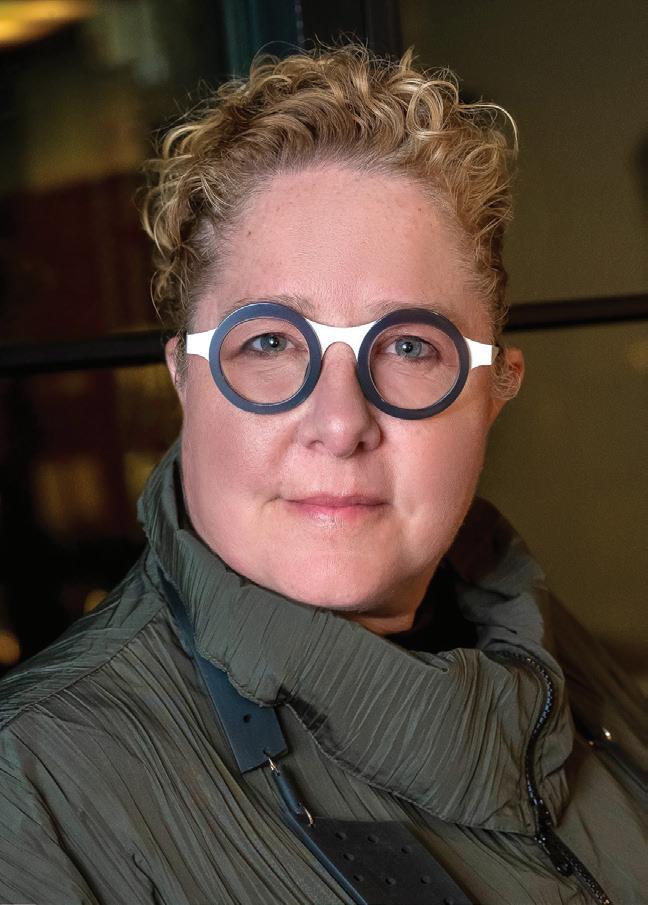

The California Association of School Business Officials is the premier resource for professional development in all aspects of school business. Founded in 1928, CASBO serves more than 24,000 members by providing certifications and training, promoting business best practices, and creating opportunities for professional collaboration. CASBO members represent every facet of school business management and operations. The association offers public school leaders an entire career’s worth of growth opportunities.
As the recognized authority in California school business, CASBO is a member-driven association that promotes ethical values; develops exceptional leaders; advocates for, and supports the needs of, members; and sets the standard for excellence through top-quality professional development and mentorship, meaningful collaboration and communication, and unparalleled innovation.
For the past 16 years, CASBO has been dedicated to the organizational planning discipline as a method for guiding the association into a successful future. Last year, the association completed its sixth such plan, CASBO by Design 2.0, a living, breathing document that guided the association in its long-term planning process, which is grassroots in nature, invigorating in procedure and motivating in outcome. Work on our next strategic plan began in 2021.
CASBO has long been committed to organizational planning because the approach has consistently helped the association envision its future and determine the clear steps to get there. The road map that strategic planning provides has allowed CASBO to remain focused on its unique mission, goals and objectives and to respond effectively to a continually changing environment.
For more information on CASBO by Design, visit casbo.org > CASBO + You > About > CASBO By Design.
Stay connected casbo.org
Publisher
Tatia Davenport
Features editor
Julie Phillips Randles
Contributors
Vicky Boyd
Nicole Krueger
Jennifer Snelling
Art Director
Sharon Adlis
Ad Production
Tracy Brown
Advertising sales manager
President
Tina Douglas
San Dieguito Union High School District
President-elect
Eric Dill
Carlsbad Unified School District
Vice president
Aaron Heinz Colusa County Office of Education
Immediate past president
Diane Deshler
Lafayette School District California
Cici Trino Association Outsource Services, Inc. P.O. Box 39 Fair Oaks, CA 95628 (916) 961-9999
Published June 2023

Does
As a Third-Party Administrator (TPA), SchoolsFirst Plan Administration expertly manages the day-to-day responsibilities of California school employee retirement plans.
Districts choose us for:
• Established expertise in administering school employee retirement plans since 1982.

• Extensive knowledge of California school districts.
• Our commitment not to charge district fees.
• Education tools and guidance to help employees with their retirement strategies.
We’re honored districts trust us to operate their plans with the highest level of service and integrity.
We want to help your district too.
Adaptability is undoubtedly an essential business skill in today’s fast-paced world, but it’s important to recognize that there can be too much of a good thing.
Adapting, in the short term, is good. During the pandemic, we exponentially adjusted our strategies to align with the ever-evolving circumstances. We adapted constantly to address the immediate challenges. Adaptability requires us to follow the direction set by others; we adjust ourselves, our processes, our policies and practices to the rules others create.
However, too much adaptation without considering the long-term sustainability of the strategies can result in compromises in stability, efficiency and even our well-being. It’s important that we strike a balance between flexibility and stability – ensuring that changes are purposeful. After all, continuous high-pressure situations can lead to burnout, decreased morale and reduced productivity.
At the 2023 CASBO Annual Conference, we talked about how we’ve over-adapted to reporting requirements and government regulations. As drivers of California’s public education operations, we have the opportunity to drive our systems sustainably well into the future by collectively and consistently communicating our needs to those affecting our public education system – the technology creators, state agencies and businesses that support us.
What we need is a smart, forward-thinking, collective voice around what does and does not make sense given today’s landscape.

This means driving our expectations to affect and better the outcomes, impacts and, most importantly, the human experience for those involved in education. We have the power to define the systems WE use, as well as how we use them, in a manner that aligns with our goals, values and expectations.
As the business engine behind the largest education system in the country, we are truly in a place to lead and add value to every element across public school operations and business.
We do so by:
Advocating for change. This includes working with policymakers and education authorities to advocate for changes in regulations and reporting that hinder innovation, and creating an environment where innovation can thrive within the constraints of government regulations – optimizing human productivity.
Leveraging technology. This looks like using software and digital tools to automate repetitive tasks, track data more efficiently and simplify reporting. By having a collective message around our need for simplified administration, we can innovate around the business processes supporting our local education agencies.
Establishing open communication channels. This means collaborating with various organizations, agencies and departments to ensure we’re working together efficiently and sharing information across the education enterprise.
Fostering adaptability. By maintaining a strong sense of innovation and commitment to long-term goals, we can truly affect the next generation of school business. This requires an attitude of adaptability – but at just the right level.
By taking these steps, we’ll ensure we’re flexing, innovating and adapting on our terms and at the proper scale. If you’d like to be part of raising our collective voice, please reach out to me at tdavenport@casbo.org z z z
Tatia Davenport CEO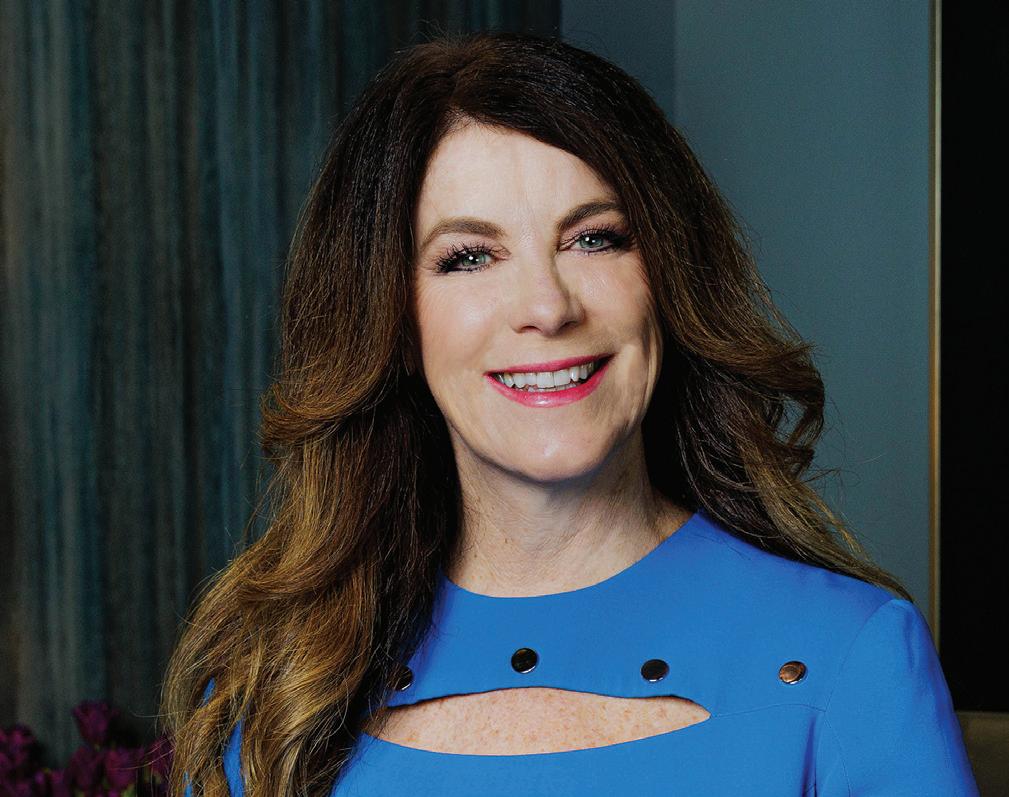
Let’s face it. Dealing with health insurance can be both difficult and at times, downright frustrating. That’s why working with the team that has been making this process easier on its members for more than 35 years makes sense.

Let CVT help you through the confusion. Contact us today!
call (800) 288-9870

I was sitting in a meeting recently to discuss succession planning within an organization. Someone chimed in and talked about how they were investing in their management team and sending them through 12 weeks of leadership training. That’s impressive, and I so appreciate the investment in employees of the organization. But in my mind, something was missing.
We should invest in all levels of the organization. Often, we think about the levels at the top, while our entry-level positions are not top of mind. Right now, we are all struggling with recruiting staff in various positions throughout our districts. We are all dealing with multiple vacancies throughout our organizations, and most of them are at the support level. If we can’t get people to apply, our mindset must shift. We need to start within our organization and begin to grow our own.
When you hire an account clerk, think about how you can train them to become your next fiscal director. That bus driver, when you finally find one, could be the next transportation director. The new custodian, your next maintenance and operations director. Because it’s so difficult to hire people right now, once we find them, we need to think about how to keep them.
One way to keep them is by providing opportunities to grow within the organization. When you think about professional development, think about everyone in the organization, not just management. Invest in them. Provide them with opportunities that stretch their capabilities. Expose them to areas they may not otherwise be exposed to. What you’ll find is an employee who is excited to come to work every day because they feel valued.
By making them feel valued for their contributions to the organization, your employees will be more engaged in the work they do. Be sure to commend them for the impact they have on students. Highlight the work they do on a regular basis, and always give credit where credit is due. I have never heard anyone complain about hearing how much they are appreciated!
I know we have many leaders in the field that do this already. Let’s celebrate those who find ways to bring along others. Let’s build each other up and help one another reach our full potential. Let’s find ways to cultivate leadership at every level of the organization. Don’t wait until someone becomes a manager to invest in them – invest in them early in their career. That’s how you will get people to stay in an organization. That student
worker could be the next CBO. In fact, that student worker might be the next interim superintendent. I know because that’s my story!
I hope you’ll help me embrace my theme of “Celebrate Members! Cultivate Leaders!” in the coming year. It is my honor to serve as this year’s CASBO president. z z z
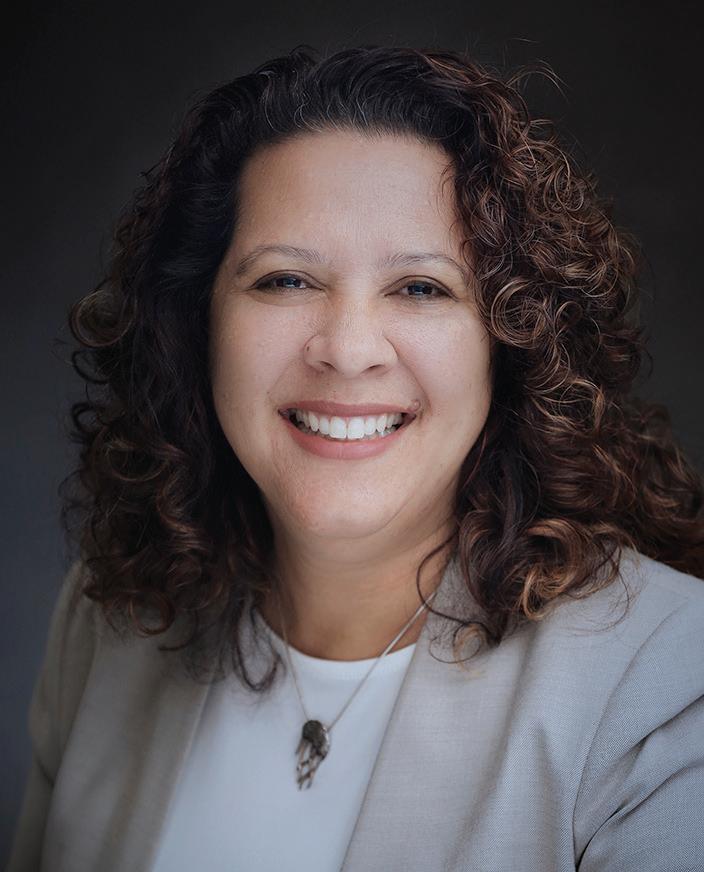 Tina Douglas President
Tina Douglas President
 By Daniel Goleman
By Daniel Goleman
Many people assume that having emotional intelligence means being“nice.” But this perception obscures some fundamental benefits to developing one’s EI. For example, simply saying someone is nice can belie the fact that they’re only nice to some people and not others. Or, if you think that being nice simply means being a pushover, you might not take advantage of the EI framework’s capacity to teach you about productive conflict management. You might also fail to consider or check the dark side of your own EI — an ability to influence or manipulate someone without their interests in mind. By understanding how EI actually works, you can have powerful, productive conversations that build up your ability to influence and lead across all your relationships.
In the 25 years since my book Emotional Intelligence was published, one of the most persistent things I see people get wrong about the concept is that it equates to being “nice.” But it doesn’t, and misunderstanding this can get people into trouble.
The first thing that often comes to mind when someone says a colleague is “nice” is that they’re pleasant to work with. But this attitude can obscure more subtle challenges. Take, for example, the question of who the person is nice to.
I think of a manager I knew who was charming, polite and very willing to please – to clients and to her boss. She was undeniably nice to them. But when I spoke to people who had worked for her, I found that she created a toxic workspace for her direct reports. She was hypercritical, aloof and abrasive. All of these relationships matter when developing your emotional intelligence.
On the flip side, especially in some competitive business contexts, I also see niceness interpreted as someone who
tries to avoid confrontations and is thus easily manipulable. Why would you want to work on your emotional intelligence if it just means that you’re going to be walked all over? Or, if you’re responsible for designing development for your people, why would you want to create a company of “nice” people – don’t you want to create a company of people who are “strong?”
In fact, being skilled in each of the four components of emotional intelligence would allow you to have
confrontations when you need to, and to do it more strategically and productively. As I’ve written about elsewhere, those components are: self-awareness, selfmanagement, social awareness and relationship management. (You’ll notice that none of these is aligned with “niceness.”)
How do these concepts apply to handling a confrontation? If you’re worried about being walked all over, you might be prone to err too much in the other direction, venting your anger at the person and exacerbating the situation. If you are truly conflict-averse, you might avoid the confrontation altogether. Emotional intelligence provides a middle way between these extremes. Strong selfawareness and self-management would let you control your initial impulses or any anxiety you might have around the conversation. A highly developed sense of empathy – that’s part of social awareness – would allow you see the situation from the other person’s point of view, so you could present your argument to them in a way that makes them feel heard, or that speaks to their own interests. And handling conflict is an important part of relationship management. You’d say what you have to say, clearly and strongly, and in a way the other person can hear.
Take, for example, the founder-CEO of a company I know. He has always avoided conflict; this became a particular problem for his company because he shied away from ever telling his employees that they needed to work harder. It got so bad that he had other employees calling him telling him that their colleagues were slacking off so much that it they couldn’t do their own jobs. So the CEO began working with a coach who helped him speak to the laggards, telling them clearly what he expected of them – without threats or blame, but also without passivity. And to his surprise, the conversations went smoothly and
the former slack-offs started pulling their own weight. Since then, he’s becoming much more assertive about confronting his shirking employees.
This is a common story – I’ve seen many people develop their ability to manage confrontations strategically in this way. This is emotional intelligence at its best, and I don’t want people to miss out on its benefits because they dismiss it as passivity.
However, it is also possible for people who display certain kinds of emotional intelligence to be overly strategic in their approach. (This disadvantage gets obscured if you think of EI as just being “nice.”) That’s because having strong EI means that to some degree you have the ability to manage the emotions of those around you as well as your own. This can quickly become problematic.
Take empathy. There are three different kinds of empathy that reside in different parts of the brain: Cognitive: I know how you think. Emotional: I know how you feel. Empathetic concern: I care about you.
Let’s say you’re really good at the first two of these but not the third. Alone they can easily be used to manipulate people. We see this in many overachieving bosses in command-and-control cultures: They tend to be pacesetters who get promoted because they have very high personal standards of excellence. They are great at pushing people to meet short-term targets – they communicate well because of their cognitive empathy and know their words will carry weight with their employees because of their emotional empathy – but because of their lack of empathetic concern they don’t care what the cost is to the person. In addition to being morally wrong, that creates emotional exhaustion and burns people out.
One CFO at a healthcare system, for example, was fixated on the organi-
zation’s bottom line. He used what he knew about the top management team to convince them to ratchet up the number of patients each physician had to see in a given period to increase profits. He didn’t care about the emotional cost and physical toll this took on his physicians. Eventually an executive coach, however, pointed out how badly he needed to boost his empathic concern, citing concerning signs of depression and anxiety among the medical staff as well as the high turnover rate.
It turned out that the CFO was already adept at displaying empathetic concern for family and friends, but he had not demonstrated it at work. Under the coach’s guidance, he was able to adapt this skill for a high-intensity workplace. He started listening to the complaints of his medical staff and collaborated with them to identify a more humane level of demand.
Leaders who develop their emotional intelligence more deliberately will be more attuned not only to all aspects of empathy, but to all four components of emotional intelligence, in all the relationships they encounter. Believing that emotional intelligence simply means being “nice” obscures what makes this framework so useful – and prevents leaders from having powerful, productive conversations that build up their ability to influence and lead in all their relationships. z z z
A version of this article appeared in the December 22, 2020, issue of Harvard Business Review. Reprinted with permission.
©2023 Harvard Business School Publishing Corp.
Piper Sandler is a leader in providing financial services to C alifornia schools. Our team of dedicated K-14 education finance professionals has more than 1 50 years of combined experience and service to the education industry.

General Obligation Bonds | Certificates of Participation | Mello-Roos/CFD Bonds Interim Project Financing | Debt Refinancing/Restructuring |
Timothy Carty MANAGING DIRECTOR
+1 310 297-6011 timothy.carty@psc.com
Christen Gair MANAGING DIRECTOR +1 310 297-6018 christen.gair@psc.com
Rich Calabro MANAGING DIRECTOR +1 310 297-6013 richard.calabro@psc.com
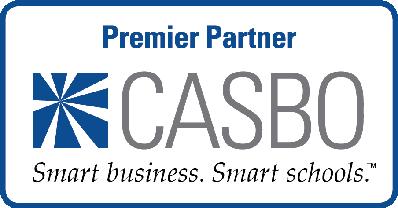
Celina Zhao ASSOCIATE +1 310 297-6019 celina.zhao@psc.com
Jin Kim MANAGING DIRECTOR +1 310 297-6020 jin.kim@psc.com
Halina De La Rosa ASSOCIATE +1 310 297-6033 halina.delarosa@psc.com
Ivory Li MANAGING DIRECTOR +1 415 616-1614 ivory.li@psc.com
Mark Adler MANAGING DIRECTOR +1 310 297-6010 mark.adler@psc.com


Over 450 California public school districts have joined together to make SISC what it is today.
We have a 42 year history of providing our members with coverage for workers’ compensation, property and liability and health benefits.

Districts join SISC for our consistently low rates, but they will tell you our service is the reason they stay for decades.

We’d love to serve you, too.
Interested in membership?
Let’s talk. Call us at (800) 972-1727 or visit www.sisc.kern.org
BACK IN THE PRE-INTERNET DAYS, Gary Stine dreamed of becoming a programmer.
At age 16, he was taking computer classes by day and working in data entry for a small payroll company after school. Now, as executive director of support services for the Orange County Department of Education, Stine spends his days wading through a different kind of code – the statutory code that governs everything school districts do.
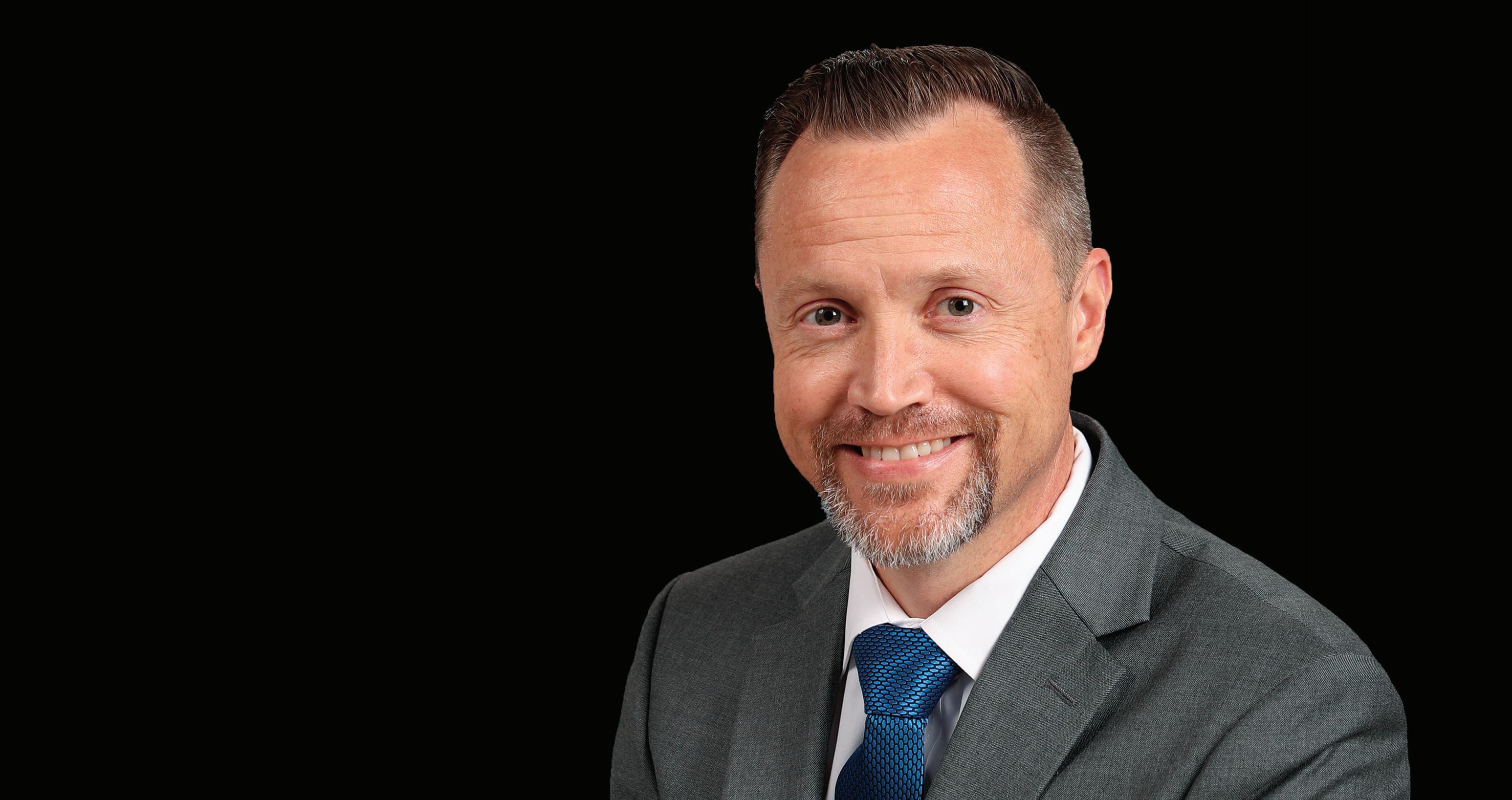
Education code has become a point of fascination for him; one that, surprisingly, dovetails nicely with his programming expertise. “The skills I use to troubleshoot in programming are the same ones I use to dig into legal code to figure things out. I use the same kind of analysis,” Stine says. “Even though education code looks chaotic, there’s logic behind it.”
His interest in education law drove him to join CASBO’s Legislative Committee, where he draws on his programming background to analyze and pull data on proposed legislation to ensure legislators understand the financial impact their laws will have on school districts. “With every decision they make, somebody has to pay the price, and it’s usually school districts,” he says. “We want to make sure that’s clearly communicated. We need to make sure the business side of education has a voice.”
Becoming a programmer wasn’t the end game for Stine, whose curiosity led him down a path he never expected. Working as a software development consultant, he had contracts with two school districts in Southern California. One of them, Colton Joint Unified School District, offered him a job as IT manager, and he made the leap to K-12 education. After a few years, the 70-mile commute became too much, which led him to take a position in IT at the Orange County Department of Education, where he managed a team tasked with developing payroll, human resource and related systems. “No matter where I went in my career, I always found myself coming back to payroll,” he says.
As applications development manager for the county, one question kept plaguing him: Why do school districts do things the way they do? He went back to school and earned a master’s degree in public administration to get a better handle on the why’s behind school business.
In the process, he developed a fascination with the finance side of education, school budgets and bonds, which led him to shift his focus to school business support, and take on his current role overseeing services provided to school districts. This includes application support for finance and human resources, credentialing, retirement services, Local Control
and Accountability Plan (LCAP) review and approval, and payroll services.
When asked whether he found the answer why school districts do what they do, he noted that “everything we do is tied to a law,” so he’s spent the last 11 years building his knowledge and expertise in the codes that govern school business. “I feel like my skill set on the IT side and my background in payroll have merged in nice way that has made me effective in my career. The systems thinking I’ve developed over the years applies to most of the things we do,” says Stine, who is infamous around the office for his heavy use of whiteboards and flowcharts. “I approach everything with that systems mindset. I diagram everything out to make sure we’re doing things in a logical way.”
But it’s not all about logic. It’s the soft skills – his ability to adapt, connect and work with people from diverse backgrounds – that glue things together.
“I owe everything to my family, the amazing mentors I’ve had throughout my career, and talented and dedicated people I’ve had the good fortune to work alongside. They are the reason I’m where I am today. I feel very lucky to be part of this industry, and it’s an honor to serve.” z z z
interest





NATIONWIDE TEACHER VACANCIES have left school districts struggling to recruit and retain educators, and many have had to get creative to fill in the gaps. Working for a company that serves 4,300 school districts across the country, Chris Cuevas has seen it all.
As vice president and regional manager for American Fidelity, which provides employee benefits for education professionals, he’s uniquely poised to offer insights about how districts in other states are successfully addressing the issue.
“Since we work with so many school districts across the country, we see a lot of different approaches and strategies for recruitment and retention,” he says. “If there’s something we can offer to schools in California that we saw in Oklahoma, we look for ways to transfer that knowledge and introduce strategies they may not have seen before.”
One of the simplest and most often overlooked actions a district can take is to educate employees about the full extent of the benefits they already have at their fingertips.
“Within a school’s budget, nearly onethird sometimes more, goes toward medical benefits. Yet when you survey employees in those school districts, despite nearly all saying those benefits are very important to them and their family, only about one-third say they
fully understand those benefits,” he says. “There’s a huge opportunity lost there. When you put the total package together, so much is being invested in their health and wellness, there’s so much value we place on it, and that’s something they need to be aware of. We frequently ask our schools, if you had 5 minutes with every single employee in your district, what would you like to tell them, or what would that message be? We have the ability to deliver that for them.”
Understaffed districts with strained resources may not have the time to thoroughly explain their benefits to every employee, but Cuevas is happy to do the legwork. Connecting with people and building relationships is one of the things he loves most about his job.
Coming from a family of educators –his mother was a preschool teacher, his older brother is a sixth grade teacher and his mother-in-law works in a district IT department – he finds satisfaction in using his financial expertise to help districts and their employees.
“They’re out there teaching our kids and doing what they need to do on a daily basis. But who’s out there taking care of them?” asks Cuevas, who earned his B.S. in business from California State University, Fresno, before landing his first job as a credit manager for Wells Fargo. When a friend recruited him
to work for American Fidelity, he had never even considered insurance as a career path.
After more than 16 years with the company, he considers it not only the best professional move he’s ever made, but a great personal one.
“We do what I feel is incredibly valuable work by helping people out there in education every day,” he says. “Being able to get up in the morning and be proud of the company you work for and the work you do is special.”
It’s what fuels him to constantly look for ways to create value for his clients – and also for CASBO, where he served as associate member liaison for the Central Board of Directors before joining the Associate Member Committee.
“I want to provide value as a Strategic Partner for CASBO,” he says. “I want to be a resource for them. It’s about not being limited into a box of what you can do. I like to ask people, ‘What troubles you today?’ and then do what we can to help with that. The ultimate compliment is being called a partner to our schools; that brings me joy.” z z z
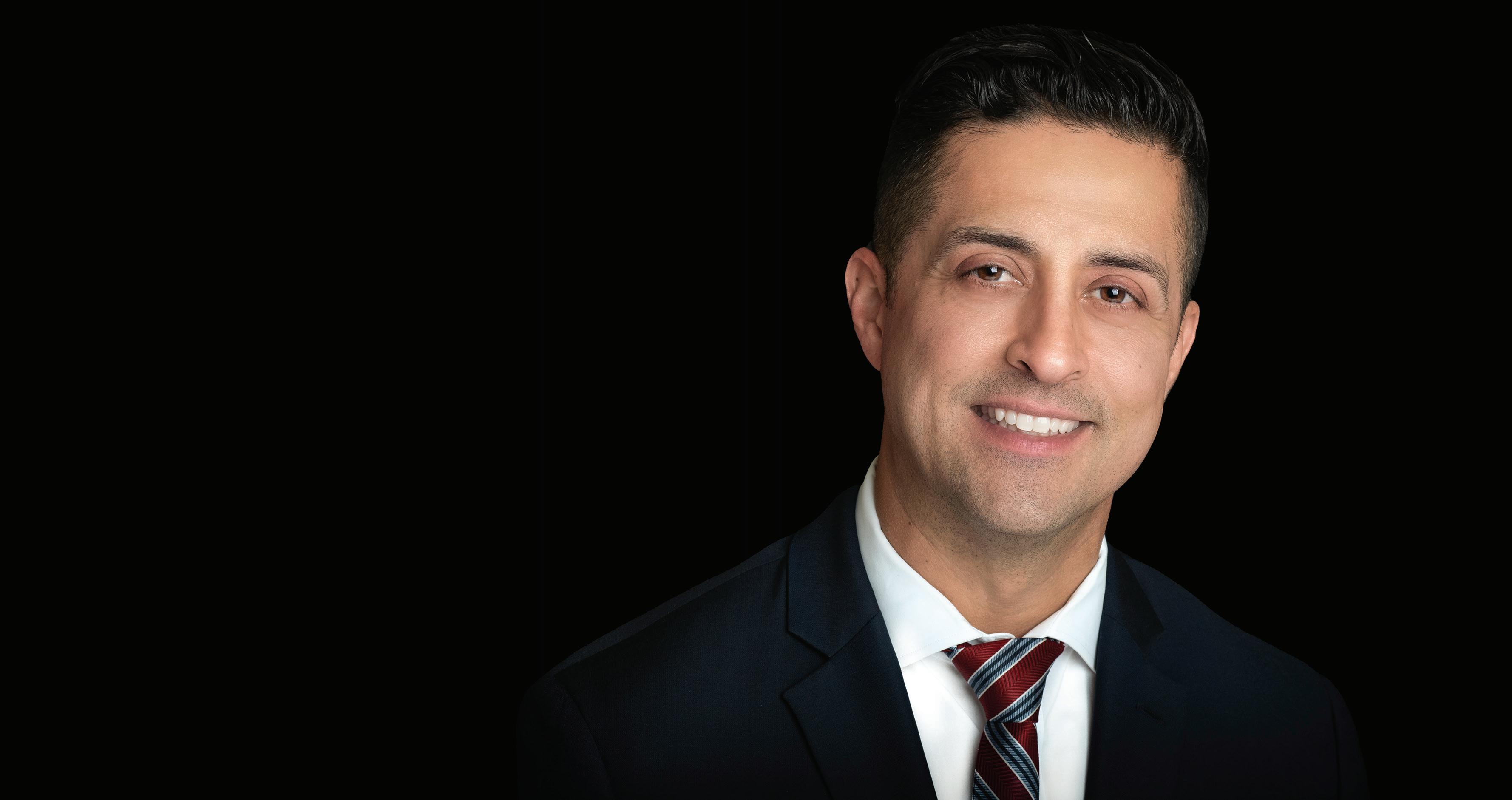
He’s always looking for ways to help districts take care of their employees
When a school district’s plan to secure new Chromebooks with federal funding for its K–12 students was nearly derailed by microchip shortages, ODP Business Solutions delivered.


The school district was set to purchase $6.5 million of new Chromebooks for students in 2021; however, 2020’s global manufacturing strain caused a shortage in microchips that the original equipment manufacturer (OEM) needed to build the Chromebooks. This disruption meant the OEM would miss the district’s deadline, leaving nearly 15,000 students and teachers without vital technology.
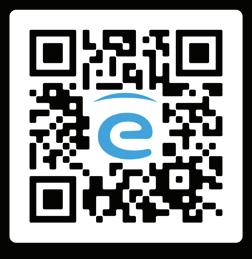

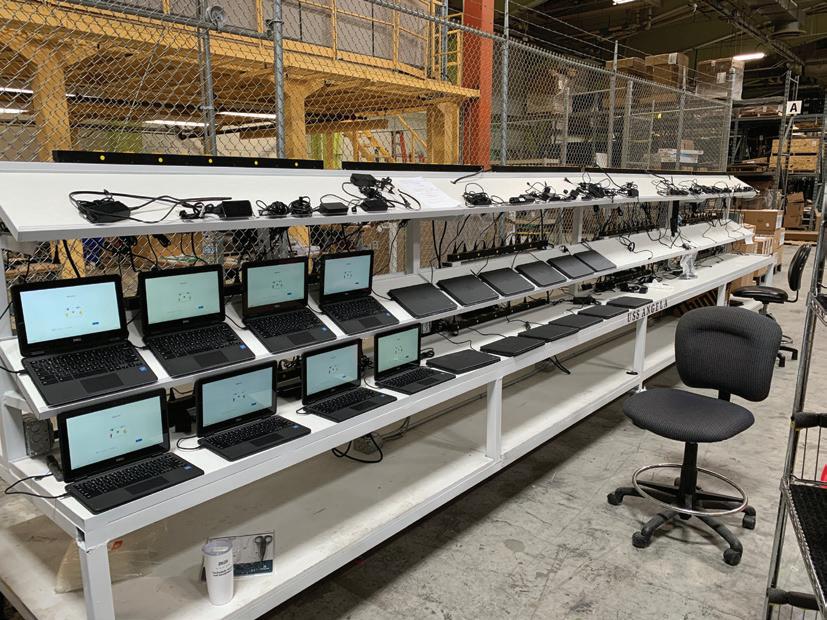
Fortunately, ODP Business Solutions already had a solid relationship with the school district, and the teams agreed that keeping the current timeline and working with a new supplier was the best option. Leveraging its industry experience and connections with other OEMs, ODP Business Solutions quickly found another supplier that had the technology available and could meet the timeline. Once the Chromebooks were delivered, ODP Business Solutions connected with a local Disabled Veteran Business Enterprise (DVBE) to provision each device and rewire 401 carts at the district’s schools to enable charging and safekeeping.
The project was bigger than the delivery of Chromebooks: Its success meant that students and teachers could return to school with the technology they expected.




Heather E. McGowan stands out in a crowd even before she begins to interact and essentially predict the future. A selfproclaimed glasses addict, McGowan rocks the greatest collection of eyewear since Elton John – and the self-confidence to show off thick, white frames, neongreen space goggles or soda-bottle circles.
Her approach to life is just as unique, just as fearless.
McGowan, who is known as a future of work strategist, is all about changing the mindset around working through her consulting work and keynote addresses. And how accurate is her data interpretation? She and co-author Chris Shipley published The Adaption Advantage in April 2020, just as every industry in the world was reinventing its approach to labor.
They clearly penned their advice long before COVID entered the lan -
guage. The Empathy Advantage: Leading the Empowered Workforce publishes in 2023. Workplace future discussions used to focus on how technology would replace human knowledge. Today, they focus on the humanization of work itself, she believes. And her own life bears this out, as she recently took care of her terminally ill brother.
“Time is a nonrenewable resource,” she wrote as a contributor to Forbes. “We act like our money is finite and our time is infinite, when it’s the inverse that’s true. No one knows their expiration date.” But math breaks down our lives into 100 10-minute blocks of time each day.
“How many of our 100 daily blocks are we willing to spend commuting or doing unnecessary tasks to feed presenteeism? For example, a recent study found that people are spending 67 minutes a day sending unnecessary emails
to prove they’re working, these efforts are referred to as digital presenteeism. That’s nearly seven wasted blocks a day, and more when you consider those emails require responses – the waste multiplies,” McGowan notes.
Her clients range from Autodesk, Cisco, Google and Biogen to The World Bank, BD Medical and Vanguard. She also serves on the advisory board for Sparks & Honey, a New York-based agency focused on the future for brands. She holds a BFA in industrial design from the Rhode Island School of Design, an MBA in entrepreneurship and finance from the Babson F.W. Olin Graduate School of Business, and she trained in improvisation for a year at the famous Second City in Chicago.
“During the pandemic, as we merged our personal and professional lives, we experienced having agency to decide
Future of work strategist shares her take on critical employment issues
when, where and how we work. It may be hard to put that toothpaste back in the tube, even if an economic recession swings the power pendulum back toward employers,” she writes.
No wonder she was ranked LinkedIn’s No. 1 global voice for education in 2017, and a top female futurist in 2020.
CASBO sat down with McGowan, also a keynote speaker at the CASBO Annual Conference, to get her input on the future of work, professional learning and artificial intelligence.
What’s one thing you thought you knew that you found out you were wrong about?
I thought I wanted to speak so that I could write books, but it turns out I write books so I can speak. I offer this because we often do not correctly know what we want until we experience it. I have heard so many stories of folks who go through nursing school or an MBA program and then realize they do not want to work in the function for which they have often myopically trained.
The pandemic was a great example as well. In year one of Microsoft’s workforce study, boomers were resistant to work from home/work from anywhere, while Gen Z was very comfortable. Fast forward to a year later and boomers had become very comfortable working remotely, with some folks even moving to vacation homes or moving away from offices, while Gen Z realized it was harder to create professional networks or find mentors essential to advancing their careers.
Experience changes perspective.
What’s the best advice you’ve ever received? From whom?
I had just graduated from Rhode Island School of Design, and I was quite full
of myself. I was a lifeguard and I had completed my degree in industrial (product) design. I had designed a viable solution for spinal immobilization for use in a water rescue. This is the kind of solution one would use in a diving accident with suspected head injury.
I had a great mentor network, and one of my mentors owned a medical design consultancy. I approached a large medical products company and they agreed to meet with me, and I brought my mentor. I was so excited about what I had designed and my depth of knowledge from years as a lifeguard that I over-explained my project, sucking all the energy and oxygen out of the meeting. My mentor took me aside and said “You are smart and clever, but you have yet to learn to read your audience. You are so focused on what you want to say that you have no awareness about what your audience wants and needs to hear.”
I was stunned. My ego was bruised, but I knew it was really important information. From that moment on – whether as a consultant, an individual contributor, a leader or a speaker – I focused on my audience, I never took their time or attention for granted, and I customized my messages for exactly the information they needed and nothing more.
You’re an expert on the future of work. Briefly, what does the workplace of the future look like?
The honest answer is I do not know specifically, and neither does anyone else. What I do know is we will increasingly collaborate with technology. We will shift from learning in order to use the technology tool to learning from and with the tool in greater coordination. We will work increasingly in collaboration with both tools and other humans.
Tasks, notably routine and predictable tasks, in isolation will increasingly be
I thought I wanted to speak so that I could write books, but it turns out I write books so I can speak.
outsourced to technology. Humans will work on the complex and messy tasks, and projects that employ our uniquely human skills like creativity, communication, empathy, divergent thinking, compassion and connection. Humans are the greatest value creators in work and, as such, workplaces will be designed to optimize human performance, connection, collaboration and comfort.
Pre-pandemic workplaces were designed like factories for knowledge work, where the humans were cogs in a system. I do not know yet what the workplace of the future looks like, but I do know that we will only be successful if we place humans at the center of that design process.

What outdated paradigms of the past do leaders need to let go of to succeed in the future?
1. The boss as an unquestioned expert, myopically driving productivity with domination, fear or humiliation.
2. “Because I said so” or “That is how we have always done it” attitudes.
3. The idea that your people work for you. Instead, the most impactful leader is one who focuses on empowering those around them; the leader cannot be successful unless the team is successful. The new leader realizes that they work for their people – enabling their success.
4. Workaholism. Workaholism and excessive hustle cultures create toxic work environments.
5. Counting hours while myopically focusing on productivity. Focus on value and performance instead.
You’ve said the COVID-19 pandemic was a great catalyst for business transformation. What did you mean by that?
We were forced to rely on many tools that were readily available – from on-
line learning to remote collaborative technology tools. The pandemic forced (belated but necessary) behavior changes. We lept forward five years in our progress on digital transformation in the first 60 days we went into lockdown (McKinsey). We sped up our migration to the cloud to twice the speed (Accenture). And we increased the rate at which we hand off tasks to technology (World Economic Forum).
Most importantly, we trusted our people to work unsupervised, and they do so superbly with agency and autonomy. Now imagine what we could with those same behaviors without the stress of a pandemic!
Experience changes perspective.
You believe there’s power in diverse, equitable and inclusive workplaces. What does that power look like and how can leaders leverage it? Power comes from the perspectives, insights and engagements of diverse experiences. When an organization lacks diversity, they do not know what they do not know. They are often completely unaware of the blind spots and cognitive biases that impact relationships with both their employee/talent base and the markets they seek to serve.
In the U.S., our markets are increasingly diverse. On the racial front alone, we do not have a racial majority
in the 18 and under demographic. The rate at which folks are identifying as being part of the LGBTQ+ community is doubling every generation. We are an aging society where people over 65 will soon outnumber people under 14. Women have been outearning men in degrees since 1982, with more than 10 million more degrees earned by women than men. And because of our outdated ideas about work and childcare, we are not harnessing that talent and potential.
We are just starting to scratch the surface of understanding the power of tapping into neurodiversity. We have not yet, in earnest beyond efforts by

The most important professional development to provide is mentorship.

Trust SELF, the member-owned organization that has protected California's schools from catastrophic liability losses for 37 years.

We are here for you when your district needs us most.
 Heather E. McGowan
Heather E. McGowan
academia, begun to address the decline in social mobility, another area ripe for diversity inclusion. Collectively, if we close the disability unemployment gap, Accenture predicts it would add $25 billion to GDP in the United States. If that is not motivating enough, companies with diverse talent pools have outperformed the S&P 500 for the past 20 years.
You make the case for everyone being dedicated to perpetual learning. What should organizations be doing to support and sustain workers throughout their careers?
The reality is the skills gap will never close. We must change our perspective on this expectation. A skills gap forms when a human demonstrates a skill and the market values that skill more than supply – that is actually progress. Given that perspective change, we now need to assume that learning is simply part of work.
Workers should be hired based upon some readiness to engage initially, but also with the expectation that their education will be insufficient to carry them without additional and continuous learning. Companies and organizations will have learning opportunities, from learning through work and mentorship to technology tools, that enable learning in the flow of work, to more formal courses both online and in person.
Following up on the prior question, what kind of professional development or learning should organizations start providing?
The most important professional development to provide is mentorship. People do not leave jobs or companies, they leave bosses, managers or leaders who are insufficient mentors. The purpose of an organization was to develop value,
and the people were how that value was developed. In this paradigm, we treated humans as a cost to contain.
If we flip our thinking and realize that the purpose of a company is to develop the people, and thereby increase the organizational capacity, we will begin to view humans as assets to develop. The best way to develop human potential, especially in light of high uncertainty, ambiguity and change, is to help the humans carve their own career path through mentorship.
You’ve said there are four fundamental shifts leaders need to make to successfully lead an empowered workforce. Can you briefly describe those shifts?
• Mindset. Due to rapidly changing skills and knowledge in the workplace, leaders are increasingly managing people who have skills and knowledge they do not. With this change, leaders no longer manage people – they are enabling their success. Put another way, your people no longer work for you; you work for them. Your success is dependent upon their success.
• Culture. In the era of the all-knowing and unquestioned boss, workers vied for attention, direction, push and praise. In that sense, workers operated as competitors, an idea reinforced by destructive management policies like forced rankings that pitted people against each other in a Hunger Games–style quest to be No. 1. When team members perceive each other as collaborators, they free their leaders to become mentoring coaches rather than flag-throwing referees.
• Approach. Businesses will not be successful in getting employees to learn and adapt at the speed, scale and scope to respond to extraordinary rates of change by threatening punishment or dangling
If we flip our thinking and realize that the purpose of a company is to develop the people, and thereby increase the organizational capacity, we will begin to view humans as assets to develop.
rewards. This extrinsic approach just won’t work. Instead, shift to helping employees identify their own intrinsic motivation.
• Behavior. In the not-so-distant past, leaders were expected to take command, make decisions in certainty and drive productivity often through domination and sometimes even fear. Now, leaders must slip into the role of coach and motivator-in-chief. Leaders now guide effective behaviors, balance wellness, avoid team burnout and inspire people to do their best work. Leaders must create the optimal conditions for your team to thrive.
What’s your take on how AI and generative technologies will change the workplace of the future?

I think the mania and fear are misplaced. I’m a belligerent optimist championing team human, where technology will help
us focus on our uniquely human skills and interactions rather than incarcerate us. I love technology and I don’t doubt it will continue to transform how we live and work in the ways it already has. We can no longer remember phone numbers because we have outsourced that to our phone. We no longer navigate by maps because we rely on GPS. We no longer remember key dates because Facebook reminds us through events like birthdays or reminders where we were one year ago today. We have adapted to these changes in our personal lives and will continue to benefit from changes in technological capabilities. I do not see widespread replacement of humans by technology but, instead, we will all learn to partner with technology to do our jobs just as we have done since the abacus. z z z
Leaders must create the optimal conditions for your team to thrive.











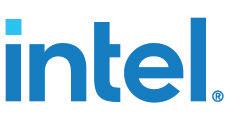
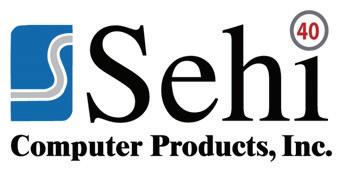



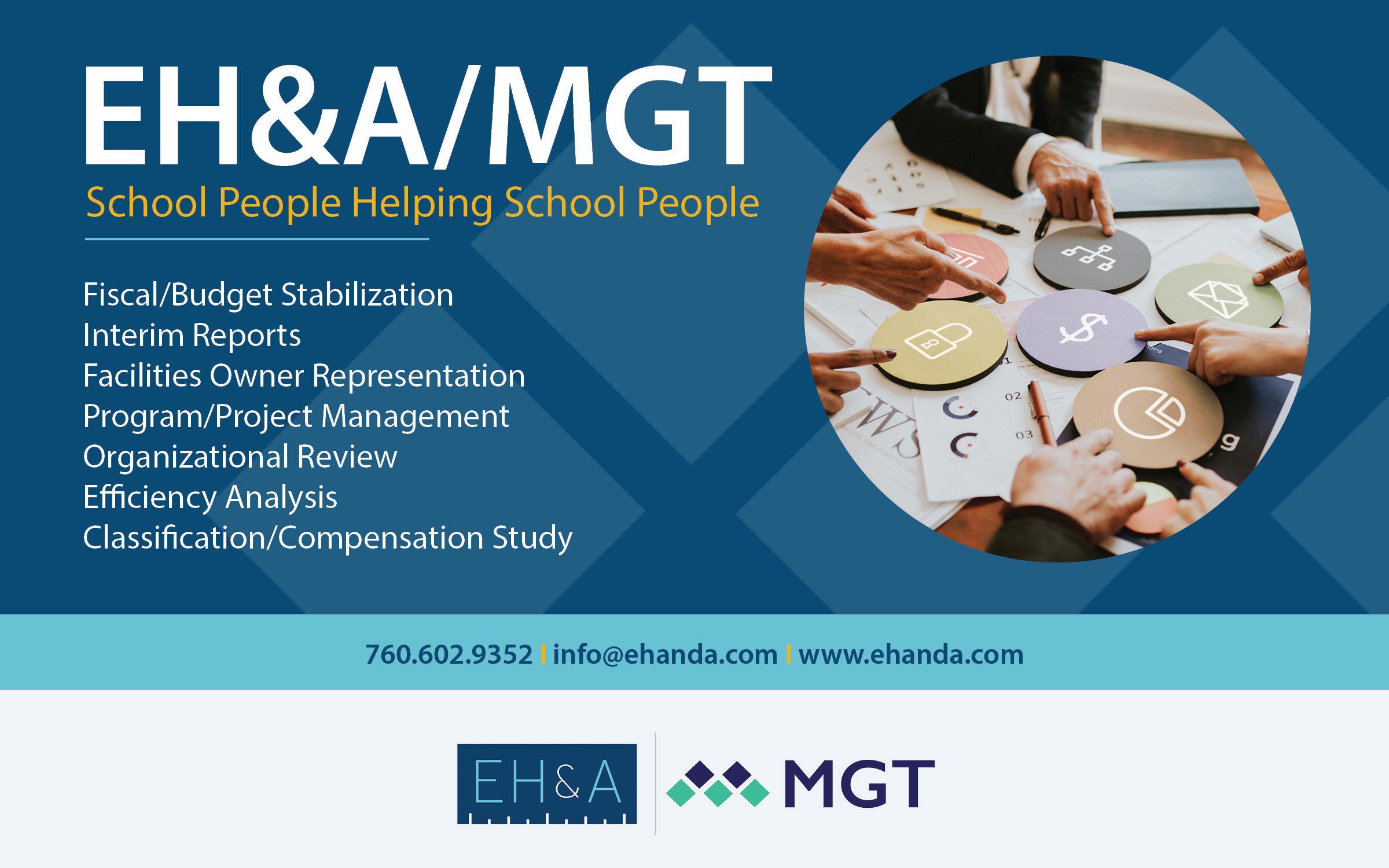

When over 3,000 school business leaders gather, the topics they care most about are sure to rise to the surface. That was certainly the case at the CASBO Annual Conference & California School Business Expo held in April. A handful of issues were consistently the topics of conversation during conference sessions, at networking events and in convention center hallways.
Data from session attendance dashboards helps narrow the list to four key topics: Artificial intelligence (AI) and generative tech like ChatGPT, women in school leadership, California’s newly emerging political landscape and how to have difficult (but necessary) conversations.
We’ll take a look at each of these hot topics and provide highlights on what they mean for school business executives.
Because of the way humans are wired, they’re generally averse to change, and recent concerns surrounding artificial intelligence and generative technologies are no exception.

“This fear of change is very real, but we can’t stop change,” says Thomas Tan, Ed.D., executive director, technology services, for Huntington Beach City School District.
Outside of some jobs that may be very repetitive, he says he doesn’t see AI and generative technology replacing school district employees. Instead, Tan foresees them helping district leaders – whether in human resources, transportation, purchasing or administration – become more creative problem-solvers, make better-informed decisions and make them faster.
“If anything, AI will be a complementary system to help us make better decisions,” he says. “It’s an extra set of brains or eyes to help make better decisions, but I wouldn’t trust it to make decisions for us. They can produce bad decisions and give us bad advice, but it’s presented to us as fact.”
Known as hallucinations, this misinformation will require human expertise and judgment to separate it from useful data.
What started out as programs that guided computers to perform tasks, like searching the web, making movie recommendations or translating foreign languages, have evolved into generative AI. OpenAI’s ChatGPT, which is an individual web-based tool rather than specific technology, has joined a number of others, including Microsoft’s Bing Chat and Google’s yet-to-be-released Bard.
Lumped into the general category of AI chatbots, this technology can respond to verbal or written requests by examining huge amounts of data on the web and generating detailed text responses or elaborate images.

“Generative AI is unique,” Tan says. “Unlike traditional AI like Deep Blue and chatbots that all were based on recognizing patterns and making predictions, this new AI can now train computers to sift through huge amounts of data.”
Teachers are already concerned about how they’ll be able to detect essays and other assignments completed by these emerging technologies. How generative AI will affect other sectors within school districts is unclear because it’s still so new and continues to change at warp speed, Tan says.
Access costs and how it will impact school budgets are also unknowns. The introductory level of ChatGPT, for
If anything, AI will be a complementary system to help us make better decisions.
example, is currently free, but parent company OpenAI also has tiered subscription models that provide access during busy use times and previews of new upgrades or versions.
Other companies have different pricing structures, and those could change as the industry shakes out and software developers seek ways to become profitable, Tan says.
Women are eager to learn about leadership support within school operations if the standing-room-only attendance at the recent “Female Leaders: Inspire, Influence and Succeed” roundtable was any indication.

“It just reinforced what we already knew,” says Lisa M. Gonzales, Ed.D., chief business officer with the Mt. Diablo Unified School District and the presenter. “There’s a great deal of leadership sup-
port that women need in business and it’s not the type of support that’s usually as prevalent.”
CASBO plans to survey members about their interest in a women’s conference to continue the discussions and provide additional resources.
“What do you need personally and what do you need professionally –because they become two different issues,” Gonzales says. “What do you want from job training, from leadership training, from political training, and how do we support and listen rather than see (female colleagues) as competition?”
Kelly Ruwe, national business solutions representative with Horace Mann, says she also was heartened by the number of attendees at the Women in Leadership Breakfast, where she was keynote speaker.
“What it tells me is there’s a lot of excitement,” she says. “They were encouraged, they were happy to be in a
There’s a great deal of leadership support that women need in business and it’s not the type of support that’s usually as prevalent.
“One day you’re an employee, and the next day you’re leading the employees,” she says. “More scaffolding is needed for leaders in departments like fiscal, maintenance, technology, transportation and others.”
Based on her experience, Gonzales says women who aspire to management roles need not just mentors, but sponsors who will expose them to leadership training opportunities, offer guidance and help them make connections. At the same time, buy-in from male colleagues is needed.
room full of talented and wonderful female leaders.”
Ruwe called on attendees to develop a professional brand, which involves how to be aware of it, how to declare it and how to assess it. She also encouraged them to learn through reflective journey, an activity that can be done individually or with a team of close co-workers.

“On a personal and professional journey, what are some things that were impactful on that journey, what they meant and how they impacted you?” Ruwe suggests considering. “This way, you’re learning a little bit more about yourself as a leader and also as an individual.”
Certificated employees have extensive training that leads to leadership roles and advancement opportunities, such as moving from assistant principal to principal. But Gonzales says the same isn’t true on the operations side, where more training is needed, particularly to support those who move from co-worker to supervisor without the advantage of a credential or master’s degree program.
“How can men support their teams, especially women, and part of that needs to be understanding the differences and gender dynamics,” she says. “They need to understand communication styles and they need to really understand what the dynamics look like and how they can step in in ways that are supportive.”
In the end, Gonzales draws from her years in management and pays it forward to other women just beginning their ascent.
“Ultimately, it really is a lot more of that coaching,” she says. “Because of the innate challenges women have in the workplace and as leaders, more support is critical. I’ve been fortunate to have many coaches along the way who have taught me to replace myself, and I am a better coach of women as a result. My job is to reach back and lift those who are following and intentionally support other women to replace myself.”
Nearly one-third of current California Legislature members are first-timers, raising more questions than answers about how the composition will affect the state’s political landscape. On the other hand, the Legislature’s party make-up
One day you’re an employee, and the next day you’re leading the employees.



has not shifted with the last election; Democrats still control both houses.
The $31.5 billion-plus projected budget shortfall should provide a first glimpse of legislators’ sentiments, says Kevin Gordon, a founding partner of Capitol Advisors, which provides legislative advocacy for CASBO.

“The overwhelming majority of the legislators weren’t around the last time there was any consideration of budget cuts for schools, let alone any part of the budget,” he says. “For the last 12 years, it’s been nothing but economic growth.”
Muddying the waters are extended state and federal income tax-filing deadlines in 51 counties affected by winter storms. About 70% of state revenue comes from personal income tax.
Rich De Nava, chief business officer, Business Services Branch, with the San Bernardino County Superintendent of Schools, agrees. “Changing the filing date provides another layer of uncertainty with respect to tax collections. When you have that type of uncertainty, we’re not certain our projections are going to be valid.”
Typically, governors unveil preliminary state budgets in January. After incorporating state income tax revenues, they release revised financial plans in May. But with the filing deadline extended well into the 2023-24 fiscal year, Gordon says state financial leaders are uncertain about collections.
A similar situation occurred when the COVID-19 pandemic shut down the
We’re starting to build some momentum to get back to where we were before COVID.
economy in 2020 and income tax filing deadlines were extended to July 15. At the time, Gov. Gavin Newsom had proposed the deepest cuts to education in the state’s history, thinking state revenues were going to crater.
The Legislature was hesitant and favored staying the course and making cuts later if needed. State revenues exceeded projections and talk of budget cuts was moot. The cycle is repeating itself as the state faces a projected revenue shortfall for fiscal year 2023-24.
“The governor is likely to be pretty darn conservative,” Gordon says. “The Legislature will be fairly averse to cutting anything, and we’ll probably end up with a budget that has a lot of cuts that could be triggered in the middle of the school year.”
Education comprises about 40% of the general fund budget. With districts still trying to catch up from pandemicinduced learning losses among students, De Nava says receiving full funding will be crucial.
“We’re starting to build some momentum to get back to where we were before COVID,” he says. “If you roll back funding, it stops progress. But I think we have the ear of the Legislature in many ways.”
Nevertheless, De Nava says many districts have developed multiple budgets that range from best-case to worse-case funding scenarios.
With Democrats controlling both houses, Gordon says he expects more battles within the party, pitting progressives against moderates.
Robert Reavis (D-Hollister), for example, replaces Anthony Rendon (D-Lakewood) as speaker of the Assembly. Considered a moderate, Reavis is interested in the role of charter schools, whereas Rendon opposed legislation that favored schools of choice.
Similar shifts also are occurring with the chairs of the Senate and Assembly education committees.
What hasn’t changed is the influence of education’s labor partners, including the California Teachers Association, California Federation of Teachers and California School Employees Association, Gordon says.
Currently, two measures moving through the Legislature would place school facilities bond measures on the 2024 primary election ballot.
Senate Bill 28, by Steve Glazer (D-Contra Costa), would provide $15.5 billion for kindergarten through CSU and UC facilities. Assembly Bill 247, by Al Muratsuchi (D-Torrance), would fund facilities from kindergarten through community colleges. Bill authors yet to include a dollar figure.
Newsom hasn’t favored either measure to date, and Gordon says supporters will have an uphill battle raising campaign funds without his backing.
“There’s some doubt about how much support, if any, CTA will put into a statewide bond measure with the lack of enthusiasm from the governor,” he says.
Most people avoid difficult conversations for fear of negative outcomes, and that sets them on a downhill path before they’ve even started. School business leaders have certainly had some very challenging conversations over the past two years, driving interest in how to improve outcomes when these inevitable chats happen.
Step 1, don’t put off the inevitable.
“Now we’re already concerned about the worse-case scenarios rather than developing an approach and strat-
What hasn’t changed is the influence of education’s labor partners, including the California Teachers Association, California Federation of Teachers and California School Employees Association.
egies to create the best situation for a healthy outcome and moving to the next step,” says Lynne Lees, communications manager with the KYA Group.
By first understanding the other person’s behavioral styles and then setting a goal and working backward, she says the chances for a positive outcome are far greater.
Approaching the conversation from a collaborative perspective also helps improve results.
“It’s not about us, although it feels like it is because we’re in charge,” she says. “But the more knowledge we’re armed with, the easier it is to help someone. Receive the message and at least communicate so you can understand all of the pieces of the puzzle. It’s really completely about the why. Once they understand the why and the purpose, you can get a buy-in.”
Asking open-ended questions helps you better understand the other person and also helps them identify their personal goals.
As you move forward in the conversation, identify clear steps you want them to take and set a schedule where you’ll reconvene to gauge progress.

“You can help give them some tools to better succeed to moving to that next step,” she says. At the same time, ask them what you can do to help them achieve those goals.
During the conversation, pay close attention to your body language. This includes staying calm, speaking softly and slowly, sitting down, leaning forward, maintaining open space and maintaining eye contact without staring.
Should the other person become emotional, Lees recommends being em-
It’s not about us, although it feels like it because we’re in charge.
pathetic but not in a way that condones the behavior.
Should emotions flare, the fightor-flight response kicks in and critical thinking shuts down. “We lose IQ points,” she says. “Wait until that chemistry comes back down, then formulate your plan.”
That may involve taking a brief break before the conversation spirals even further.
Even with the best plans, Lees says conversations can be derailed. Sometimes simply saying the other person’s name can provide the few seconds needed for the conversation leader to refocus on the next step.
“If someone says our name, psychology has us stop,” she says. “We’ll stop moving or stop talking for that fraction of a second.”
If at all possible, Lees recommends having difficult conversations in person rather than virtually since 55% of the information humans perceive is through body language.
And like many other soft skills, achieving positive results from difficult conversations takes practice.
“We’re naturally gifted to identifying patterns, and the more data we’re getting, we’re automatically going to trend to the most successful path,” she says. z z z
Vicky Boyd is an award-winning journalist who has spent more than three decades writing for newspapers, magazines and digital publications.
What hot topics in education are you focused on? Tweet us at @ CASBO to let us know.


Castaic Union School District’s Mallory Jones is new to her job in human resources. She had been working in education services and, although she had a lot of transferrable skills, this job was very different.
Castaic is a small local education agency (LEA), so Jones handles all the HR issues, from credentialing to hiring to the day-to-day functioning of the department. Learning on the job wasn’t an option because the prior coordinator had already left. The district needed her to hit the ground running. Castaic contracted School Services of California (SSC), a CASBO Premier Partner, to help boost Jones’ knowledge base and confidence with the help of a coach.
Jones has met with coach Danyel Conolley, SSC’s director of management consulting, for about a year. For the first six months, they met weekly over Zoom, with a few in-person visits. More recently, they’ve been meeting twice a month. Now 18 months into her new position, Jones says Conolley made a big difference in her experience.
In the beginning, Conolley helped Jones tackle intense staffing shortages. They worked on what a good recruitment cycle looks like, the timing of postings and managing all the little pieces like interview packets, a good set of questions and good screenings.
“In the beginning, I was learning what an HR coordinator does in a school
district and the day-to-day functions. [Conolley] helped me manage the workflow and gave me skills and strategies to help maintain during busy times,” she says. “As I got more comfortable, the coaching transformed into leadership and career coaching. [Conolley] helped me trust my instincts and intuition as a leader. She helped our district move forward with an HR department they can trust.”
Conolley is a good coach because she can relate to Jones’ situation. When Conolley first came to human resources, she was overwhelmed. “I sat in my office crying many days alone, but I also had some very important mentors who are the reason why I’m here today,” she says.
Districts offer executive coaching to bolster grow-your-own efforts, aid retention
New school business leaders face more challenges than ever before. These include managing the impacts of COVID, devising strategies to cope with rising gun violence, dealing with talent shortfalls and many more issues that have been exacerbated by constant budget crunching.
“The worst thing that can happen is to have someone courageously step into that school leadership role and quit because they didn’t have the support they needed,” she says.
Executive coaching may seem like something that belongs more in a Fortune 500 company than a district office. Still, school districts increasingly see the value of supporting their leadership teams with coaching. Among the many benefits are on-the-job training, creating an intentional office culture and talent retention – thanks to feeling supported while learning a difficult job.

Marialane Schultz is the founder and CEO of Innovative Outcomes Consulting Inc., which offers executive coaching to private and public sector leaders.
“There has not been a more important time for education leaders to have the
support they need to rise to and confront the unique challenges they are facing,” says Schultz. “It does not matter what industry you’re in, anybody who is leading people or classrooms can benefit from a coach who can help with leadership skills and self-awareness, and the abilities they need to display in their roles.”
For a new executive with little experience, a position’s first cycle or two can be very challenging. Brentwood Union School District hired an assistant superintendent who was new to the job.
“He’s very bright and has lots of school experience, but these are incredibly complex jobs,” says Brentwood Superintendent Dana Eaton, Ed.D. “When you have someone working without a net, you want to ensure they have the support they need to succeed. Coaching allows them to continue flying the plane while building it.”
That concept is crucial in an era when early retirements and experienced professionals who have left the public sector have created a hole in the leadership pipeline in many LEAs. For instance, most districts would ideally seek someone with at least seven years of leadership experience when hiring a CBO. With the current shortage, those requirements have dropped, and people with fewer years of experience are screening in for interviews.
“The staffing shortage has impacted the leadership pipeline. We realize technical and analytical skills are deficient,” says Conolley.
To counteract the lack of experience in otherwise good candidates, LEAs have begun offering executive coaching as part of the compensation package advertised in postings, especially when the district
The worst thing that can happen is to have someone courageously step into that school leadership role and quit because they didn’t have the support they needed.
is taking on someone transitioning into a new leadership role.
Fiscal Crisis and Management Assistance Team’s (FCMAT) Joel Montero facilitates FCMAT’s Coaching and Induction Program (CIP). CIP provides both weekend training and personalized coaching for CBOs.
Montero says one of the first weekend sessions demonstrated how quickly CBOs must be at full capacity. One CBO saw a person harming themselves outside their office window the prior week, another CBO sued Shell Oil Company for contaminating the LEA’s water, and a third had to contend with a school shooting incident. How can anyone be prepared for episodes like these?
“We spend a lot of time training people to prepare them for the job,” Mon-
tero says. “Unfortunately, we lose too many of them in the first or second year because they get overwhelmed. They don’t have any forum to vent and vet some of this stuff that nobody ever thinks will happen in their day-to-day job.”
A positive workplace culture comes from taking time to define the values of the district office and what it looks like to be a good leader, says Schultz. “Highperforming organizations, whether its schools or finance and banking, define the culture as well as live it and believe it every day,” she says.
Employees experience workplace culture through the big picture and the small interactions that build that picture.

For a new executive with little experience, a position’s first cycle or two can be very challenging.
Imagine that every time a leader offers an idea at a meeting, a co-worker, let’s call her Julie, offers a competing vision. This situation may make the leader feel unworthy or angry. Their thought habits may cause them to withdraw or lash out at Julie.
It may not have been Julie’s intention to supersede the leader’s idea. Instead of withdrawing or lashing out, what if the leader asks Julie what she thinks about their concept and how they might work together? Taking that pause gives everyone a chance to reset. It lets the leader avoid getting highjacked by their emotions.
Schultz recommends resetting situations like this by asking a question or drinking water. Both will help shortcircuit the leader’s limbic system reaction that causes fight, flight or freeze.
“Leadership coaching can reveal what development approaches might be important for the leader to consider, and how their thinking and actions can either propel them toward success or get in the way of tapping into their full potential,” says Schultz. “We try to help clients see, feel and think in different ways as they are engaging with others and delivering. We help them find other ways of being at work.”
Systemic support and a positive office culture go a long way toward encouraging employees to stay in their jobs, even if they are making less money than they could in the private sector.
The support that comes from a coach who can help leaders operate in an envi-

A positive workplace culture comes from taking time to define the values of the district office and what it looks like to be a good leader.
Extend the benefits of CASBO membership with our new 3-year option for Organizational Subscriptions.
Now available through July 31, this limited-time offer allows LEAs to lock in rates for the next 3 years and save up to $800 when all 3 years are paid upfront.*
CASBO’s wide range of tools, events and programs support school business professionals every stage of their career, along with the LEAs and students they serve. Highlights include:
⸱ Continuing education through School Business University, our new LMS featuring on-demand self-led courses.
Professional & leadership development through online & in-person events & workshops.
⸱ Community & networking with 24,000+ school business colleagues across California.
Hurry—this limited-time offer is only available on Organizational Subscriptions through July 31, 2023. Scan the QR code below or visit CASBO.info/3-year to sign up today!

Can’t pay upfront? Sign up at CASBO.info/3-year by July 31 to lock in pricing through June 30, 2026, and then pay annually.

ronment where social media sometimes means there is no room for error is invaluable. For example, says Conolley, CBOs used to be able to have a bad night or say something wrong at a meeting. Now it ends up on social media the next day, sometimes ending the career.
“With some of this, the only way to learn it is to live it,” she says. “Working in CASBO classes for aspiring CBOs, we noticed that we have talent out in the field that wasn’t exactly ready for the role,” she says. “But with support, they could be. In good conscience, we can’t just throw them to the wolves and say, ‘Good luck at the board meeting.’ CBOs are responsible for the fiscal solvency of the LEA. You can’t just say, ‘Learn on the job.’”
The title of FCMAT’s first CIP weekend session is “What have I gotten myself into?” That’s a direct quote from a CBO who was new to her job, says Tami Montero, FCMAT intervention specialist. Yes, she wanted the job, but as soon as she sat down at her desk, the superintendent wanted to know how much was in the budget and what they could spend it on.
“Depending on where they came from before, they may be unprepared to answer those questions or, worse, give bad information to their superintendent,” says Montero.
Having a coach through the first cycle or two in a high-stakes, highpressure leadership position can help leaders stay on the job longer. One of the most significant benefits of coaching is building a relationship that can foster a professional network. That network will be there to answer questions and offer support for years to come.

As a new employee, it can be difficult to request a coach. You just went through this interview process to prove you were the best person for the job, and now you’re admitting you need help.
“As school districts, we need to understand the need for coaching. We have a culture where all our cabinet members are assigned to coach a principal. It’s built into the fabric of our culture, so it was a natural process,” says Eaton. “The onus is on the superintendent or leader to ensure they are providing the best support they can, and sometimes that person is not the superintendent.”
Coaching does cost money, which is always a concern in resource-scarce LEAs. Yet the benefits to a school district are huge, says Eaton.
“In some of these areas, you can make mistakes unintentionally that cost thousands of dollars. Basically, coaches are trying to minimize that, but it also allows the leader to get to best practices faster,” says Eaton. “A coach can help a leader build systems and processes faster to run an exceptional department.”
Think of it in terms of short-term and long-term investments, says Schultz. “Investing in building leadership capability and readiness is a ‘pay now or pay later’ proposition,” she says. “One can invest now to increase leader and organizational performance that improves service quality, or pay later when facing average or declining performance that results in poor quality service delivery.”
There are many coaching options to meet the specific needs of an LEA. Private coaches, like Schultz, offer coaching twice monthly for 90 minutes over six months to a year, including texting and calling if something comes up in between sessions. There is an intake process, a planning process and then a three-way conversation between the client, the client’s boss and the coach.
School Services of California provides comprehensive support explic-
One of the most significant benefits of coaching is building a relationship that can foster a professional network.
itly tailored to each leader’s and LEA’s needs. Most of SSC’s coaches are recently retired CBOs or heads of HR. The cost of these services depends on the scope of work.
FCMAT offers the CBO CIP, an in-person, yearlong program that provides training over 12, two-day sessions that follow the CBO annual cycle. Participants are paired with experienced CBOs who are from similarly sized districts. The cost is $7,500.

Given FCMAT’s mandate to ensure positive fiscal health in school districts, the CIP program is more about the organization than the individual. A private coach like Schultz can be a thought partner in helping address leadership style or workplace culture.
“I am a big fan of coaching for many reasons,” says Schultz. “These executive leaders have a lot of stress on them. We try to help them manage the emotions around that and bring down their anxiety levels so they can see their way through to think about solutions. We will have succeeded if they can keep a steady hand, a level head and an open heart when leading.” z z z
Does your district offer coaching or other benefits to help employees build leadership skills? Let us know at LinkedIn/CASBO.
The Governor’s May Budget Revision revealed a $31 billion shortfall resulting in significant cuts to critical one-time grant programs, putting further strain on district budgets. Now is the time to explore an early retirement incentive, the PARS Supplementary Retirement Plan (SRP), which can help provide the needed fiscal relief for your district as we approach this fiscal cliff.
PARS provides a no-cost, comprehensive fiscal analysis to assist districts in determining the feasibility of a SRP and create the right, customized solution.
Also look to one-time dollars and/or ending balances to address your long-term retiree healthcare liabilities (OPEB), mitigate STRS/PERS cost increases and create a rainy-day fund for the future through the PARS/CSBA OPEB Solutions Program and the PARS Pension Rate Stabilization Program (PRSP)
Contact PARS at: (800) 540-6369 ext. 127 or info@pars.org; www.pars.org

To transform learning through cloud technologies, you need IT Orchestration by CDW®.

The cloud helps keep classrooms connected — no matter where learning takes place. From secure, real-time collaboration among students to enhanced workflows for administrators, see how CDW can help your organization leverage cloud technologies and accomplish more every day.
See how at CDW.com/education






It’s a journey where the people you meet and connections you make will support you for a lifetime ... and where you’ll get the exceptional professional development, advocacy and networking services you need to grow your career and build healthy organizations.
That’s our mission, and we remain committed to walking with you on that path.
If you haven’t already, we invite you to renew your relationship with CASBO. Whether you’re an individual, local education organization or business, we hope you’ll continue to play a critical role in our network!


Stifel is the leading underwriter of California K-12 school district bonds.* We assist local districts in providing financing for facility projects and cash flow borrowing, including new construction, modernization, renovation, and technology improvements. Our work with California school districts includes:

■ General Obligation Bonds
■ Mello-Roos Bonds
■ Certificates of Participation/Leases
■ Short-Term Notes and TRANs
■ Refinancing or Restructuring of Previously Issued Bonds
We give back to the communities we serve by providing college scholarships to graduating high school seniors through Stifel’s annual Fabric of Society essay competition and by supporting school-related foundations and functions with charitable contributions.
* Source: Thomson Reuters SDC, Ranked No. 1 in California K-12 bonds by par amount and number of issues in 2022.
Stifel, Nicolaus & Company, Incorporated
Member SIPC & NYSE | www.stifel.com
Northern California | San Francisco Office
Bruce Kerns Managing Director (415)364-6839 bkerns@stifel.com
Erica Gonzalez Managing Director (415)364-6841 egonzalez@stifel.com
Roberto Lee-Ruiz Managing Director (415) 364-6856 rruiz@stifel.com
Southern California | Los Angeles Office
Dawn Vincent Managing Director (213)443-5006 dvincent@stifel.com
Frank Vega Managing Director (213) 443-5077 vegaf@stifel.com